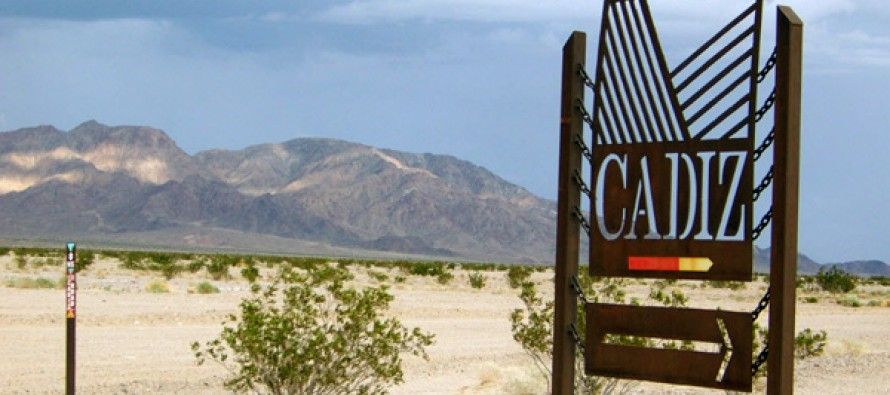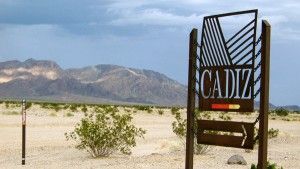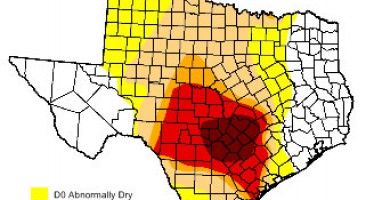Water deal turnoff helped parch L.A.

 Los Angeles sure could use extra water right now.
Los Angeles sure could use extra water right now.
But in 2002 the water-locked city forfeited a Golden State opportunity to buy drought-relief water from the Cadiz Inc. water company, mainly due to political pressure from environmental organizations. Other more nimble public water agencies and private water companies have already snapped up most of the water from what now is called Cadiz 2.0.
Cadiz is a self-described renewable resources company based in Los Angeles that owns 45,000 acres of land and water rights in the Cadiz Valley in the Mojave Desert portion of Eastern San Bernardino County. It has developed the land for growing grapes, citrus, melons, peppers, squash, asparagus and beans.
In 2002, the Metropolitan Water District of Southern California, of which the City of Los Angeles is a member, backed out of a 50-year deal with Cadiz. Los Angeles could have bought Cadiz water in 2002 at a price of $230 per acre-foot, not the nearly $1,000 per acre-foot going price in 2014.
The Los Angeles Times reported in 2002:
“The innovative and complex project envisioned storing up to 1.5-million acre-feet of surplus Colorado River water in an aquifer under a Mojave Desert tract owned by Cadiz for extraction in dry years. …
“Critics had argued that ground water extraction on the anticipated scale threatened permanent damage to the fragile desert ecosystem. Although the Interior Department ruled in August that a proposed network of testing wells around the site would deliver adequate warning of impending damage, few environmentalists agreed.”
(An acre-foot is enough to supply two typical urban households for a year.)
Another problem was publicity — that Cadiz was too politically connected with then-Gov. Gray Davis, Democratic U.S. Rep. Tony Coehlo and former Vice President Al Gore.
Cadiz 2.0 – A downsized company
In 2008, the company was reorganized and came up with a Cadiz 2.0 plan that downsized the project to 50,000 acre-feet of annual water production specifically designed to avoid perceived or actual environmental impacts.
Rather than relying on political connections, Cadiz 2.0 brought in competent management and relied on an independent panel of reputable scientists to peer-review the proposed project. The makeover didn’t deter lawsuits, but none survived in court:
- In 2012, a federal lawsuit alleging damages of the Cadiz water project to archeological resources was dismissed, as federal law was not applicable.
- In October 2013, the Laborers International Union Local 783, a construction workers’ union based in San Bernardino, Inyo and Mono counties, withdrew its case after a new hydrology report was released validating the science of the project.
- In May 2014, an Orange County judge rejected a series of environmental complaints against the project brought by a group of environmental organizations.
Other contracts
Meanwhile, in 2012 six other Southern California water districts optioned or committed to buy 80 percent of Cadiz’s 50,000 acre-feet of water to be harvested each year:
- Santa Margarita Water District (Orange County);
- Three Valleys Municipal Water District (Eastern San Gabriel Valley);
- Jurupa Community Services District (Riverside County);
- Suburban Water Systems (East San Gabriel Valley);
- Golden State Water Company (Southern California):
- California Water Service Company (San Jose).
Then on August 28, 2014, Cadiz 2.0 signed a letter of intent to supply 3,000 acre-feet of water to the Lake Arrowhead Community Services District, a water retailer. The contract price would be $960 per acre-foot of water.
Arrowhead wouldn’t actually take delivery of the water from Cadiz, but would arrange an exchange of water with a State Water Project contractor. Lake Arrowhead was the first water retailer from San Bernardino County to reserve future water from Cadiz 2.0.
Cadiz 2.0 relieving drought in other districts
A Final Environmental Impact Report for Cadiz 2.0 was certified in July 2012. The project now is in the construction phase.
Today, Cadiz 2.0 is poised to relieve impacts from California’s severe drought.
In contrast, Los Angeles’ “Water Integrated Resources Plan: 5‐Year Review,” produced in 2012 under then-Mayor Antonio Villaraigosa, provides for producing 59,000-acre feet of recycled “toilet-to-tap” water at a price ranging around $1,300 per acre-foot (see page 7, footnote 2, here).
Otherwise, Los Angeles is waiting for a drought solution from a new statewide $7.5 billion bond, on the ballot this November as Proposition 1, that would only provide a trickle of water. Half of the $2.7 billion allocated in the bond for new reservoirs would go to “Delta ecosystem restoration” in the Bay Area.
Thus, only $1.35 billion would go toward actual drought relief, adding only about 0.5 percent to the state’s existing water-storage capacity. And that’s assuming voters actually approve the bond.
Although Cadiz 1.0 in 2002 had problems that Cadiz 2.0 since has fixed, the rejected deal of a dozen years ago still would have provided a Niagara of relief in today’s parched Southland.
Editor’s note: This article has been corrected to reflect the following from Cadiz: “Lake Arrowhead is not the first water retailer to buy water from Cadiz 2.0. It is the first water retailer from San Bernardino County to reserve future water from Cadiz 2.0. ‘Buying’ happens with the approval of a purchase and sale agreement, which has not yet occurred; there’s just a Letter of Intent. The first water retailer to buy water from Cadiz 2.0 is Santa Margarita Water District.”
Related Articles
Local governments approve numerous tax increases: Part 1
This is Part 1 of a series of stories about tax increases passed throughout California in the November 5 elections.
In fighting drought, San Antonio leaves L.A. in the dust
Could cities such as drought-vulnerable Los Angeles come to regret that a “privatization” provision in the old $11.1 billion
Assembly Republicans select Chad Mayes as next leader
Come January, Assembly Republicans will have a new leader. On Tuesday, the 28 Republican members of the lower house selected




